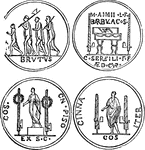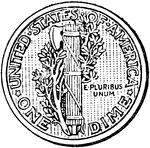Clipart tagged: ‘Fasces’

Fasces
"Rods bound in the form of a bundle, and containing an axe in the middle, the iron of which projected…
Fasces of a Roman Magistrate
"In Rom. antiq., bundles of rods, usually of birch, with an ax bound in with them, the blade projecting,…

Lictors with Fasces
"The symbolic fasces borne by these officers were probably of Ertuscan origin. The Tarquins are said…

Two Attendants, or Lictors, of a King or Consul
Lictors were guards of magistrates who carried fasces to show power to execute. Two men, one young,…
